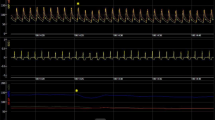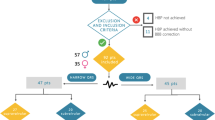Abstract
Purpose
To evaluate the improvement in electrical synchrony and left ventricle (LV) hemodynamics provided by combining the dynamic atrioventricular delay (AVD) of SyncAVTM CRT and the multiple LV pacing sites of MultiPoint pacing (MPP).
Methods
Patients with LBBB and QRS duration (QRSd) > 140 ms implanted with a CRT-D or CRT-P device and quadripolar LV lead were enrolled in this prospective study. During a post-implant follow-up visit, QRSd was measured from 12-lead surface electrograms by experts blinded to pacing configurations. QRSd reduction relative to intrinsic rhythm was evaluated during biventricular pacing (BiV) and MPP for two AVDs: nominal (140/110 ms paced/sensed) and SyncAV (patient-optimized SyncAV offset [10–60 ms] minimizing QRSd). Echocardiography particle imaging velocimetry (Echo-PIV) analysis was performed for each configuration. The resulting hemodynamic force LV flow angle (φ) was analyzed, which ranges from 0o (predominantly base-apex forces) to 90o (predominantly transverse forces). Higher angles indicate more energy dissipation at lateral walls due to transverse flow; lower angles indicate healthier flow aligned with the longitudinal base-apex path of the pressure gradient.
Results
Twelve patients (58% male, 17% ischemic, 32±7% ejection fraction, 165 ± 18 ms intrinsic QRSd) completed QRSd and Echo-PIV assessment. Relative to intrinsic rhythm, BiV and MPP with nominal AVD reduced QRSd by 10 ± 9% and 12 ± 9%, respectively. BiV+SyncAV and MPP+SyncAV further reduced QRSd by 19 ± 8%, (p < 0.05 vs. BiV with nominal AVD) and 23 ± 9% (p < 0.05 vs BiV+SyncAV), respectively. Echo-PIV showed similar sequential hemodynamic improvements. LV flow angular orientation during intrinsic activation (46 ± 3o) reduced with BiV+SyncAV (37 ± 4o, p < 0.05 vs intrinsic) and further with MPP+SyncAV (34 ± 4o, p < 0.05 vs BiV+SyncAV).
Conclusion
These results suggest that SyncAV may improve electrical synchrony and influence LV flow patterns in patients suffering from heart failure compared to conventional CRT with a fixed AVD, with further improvement observed by combining with MPP.





Similar content being viewed by others
Abbreviations
- AVD:
-
Atrioventricular delay
- BiV:
-
Biventricular
- CRT:
-
Cardiac resynchronization therapy
- HF:
-
Heart failure
- GLS:
-
Global longitudinal strain
- LV:
-
Left ventricle
- LBBB:
-
Left bundle branch block
- MPP:
-
MultiPoint pacing
- NYHA:
-
New York Heart Association
- PIV:
-
Particle imaging velocimetry
- QRSd:
-
QRS duration
- RA:
-
Right atrium
- RV:
-
Right ventricle
- SyncAVTM :
-
Proprietary algorithm for dynamic AVD programming
References
Sutton M, Plappert T, Abraham W, Smith A, DeLurgio D, Leon A, et al. Effect of cardiac resynchronization therapy on left ventricular size and function in chronic heart failure. Circulation. 2003;107:1985–90. https://doi.org/10.1161/01.CIR.0000065226.24159.E9.
Trucco E, Tolosana J, Arbelo E, Doltra A, Cate M, Benito E, et al. Improvement of reverse remodeling using electrocardiogram fusion-optimized intervals in cardiac resynchronization therapy. JACC Clin Electrophysiol. 2018;4:181–9. https://doi.org/10.1016/j.jacep.2017.11.020.
Menardi E, Ballari GP, Goletto C, Rossetti G, Vado A. Characterization of ventricular activation pattern and acute hemodynamics during multipoint left ventricular pacing. Heart Rhythm. 2015;12:1762–9.
Ciconte G, Calović Z, Mcspadden LC, Ryu K, Mangual J, Caporaso I, et al. Multipoint left ventricular pacing improves response to cardiac resynchronization therapy with and without pressure-volume loop optimization : comparison of the long-term efficacy of two different programming strategies. J Interv Card Electrophysiol. 2019;54:141–9. https://doi.org/10.1007/s10840-018-0480-6.
Arbelo E, Tolosana JM, Trucco E, Penela D, Borras R, Doltra A, et al. Fusion-optimized intervals ( FOI ): a new method to achieve the narrowest QRS for optimization of the AV and VV intervals in patients undergoing cardiac resynchronization therapy. J Cardiovasc Electrophysiol. 2014;25:283–92. https://doi.org/10.1111/jce.12322.
Thibault B, Ritter P, Bode K, Calo L, Mondesert B, Mangual J, et al. Dynamic programming of atrioventricular delay improves electrical synchrony in a multicenter cardiac resynchronization therapy study. Heart Rhythm. 2019;16:1047–56. https://doi.org/10.1016/j.hrthm.2019.01.020.
O’Donnell D, Wisnoskey B, Badie N, Odgers L, Smart T, Ord M, et al. Electrical synchronization achieved by multipoint pacing combined with dynamic atrioventricular delay. J Interv Card Electrophysiol. 2020:1–8. https://doi.org/10.1007/s10840-020-00842-7.
Zanon F, Baracca E, Pastore G, Marcantoni L, Fraccaro C, Lanza D, et al. Multipoint pacing by a left ventricular quadripolar lead improves the acute hemodynamic response to CRT compared with conventional biventricular pacing at any site. Heart Rhythm. 2015;12:975–81. https://doi.org/10.1016/j.hrthm.2015.01.034.
Forleo GB, Santini L, Giammaria M, Potenza D, Curnis A, Calabrese V, et al. Multipoint pacing via a quadripolar left-ventricular lead : preliminary results from the Italian registry on multipoint left-ventricular pacing in cardiac resynchronization therapy ( IRON-MPP). Europace. 2017;19:1170–7. https://doi.org/10.1093/europace/euw094.
Siciliano M, Migliore F, Badano L, Bertaglia E, Pedrizzetti G, Cavedon S, et al. Cardiac resynchronization therapy by multipoint pacing improves response of left ventricular mechanics and fluid dynamics : a three-dimensional and particle image velocimetry echo study. Europace. 2017;19:1833–40. https://doi.org/10.1093/europace/euw331.
Pedrizzetti G, La Canna G, Alfieri O, Tonti G. The vortex--an early predictor of cardiovascular outcome? Nat Rev Cardiol. 2014;11:545–53. https://doi.org/10.1038/nrcardio.2014.75.
Carlhall CJ, Bolger A. Advances in heart failure passing strange flow in the failing ventricle. Circ Heart Fail. 2010;3:326–31. https://doi.org/10.1161/CIRCHEARTFAILURE.109.911867.
Mangual JO, Kraigher-krainer E, De LA, Toncelli L, Shah A, Solomon S, et al. Comparative numerical study on left ventricular fl uid dynamics after dilated cardiomyopathy. J Biomech. 2013;46:1611–7. https://doi.org/10.1016/j.jbiomech.2013.04.012.
Sengupta P, Pedrizzetti G, Narula J. Multiplanar visualization of blood flow using echocardiographic particle imaging velocimetry. JACC Cardiovasc Imaging. 2012;5:566–9. https://doi.org/10.1016/j.jcmg.2011.09.026.
Abe H, Caracciolo G, Kheradvar A, Pedrizzetti G, Khandheria BK, Narula J, et al. Contrast echocardiography for assessing left ventricular vortex strength in heart failure : a prospective cohort study. Eur Heart J Cardiovasc Imaging. 2013;14:1049–60. https://doi.org/10.1093/ehjci/jet049.
Wagner GS, Macfarlane P, Wellens H, Josephson M, Gorgels A, Mirvis DM, et al. AHA/ACCF/HRS recommendations for the standardization and interpretation of the electrocardiogram. Part VI: Acute Ischemia/Infarction A Scientific Statement From the American Heart Association Electrocardiography and Arrhythmias Committee, Council on Clini. J Am Coll Cardiol. 2009;53:1003–11. https://doi.org/10.1016/j.jacc.2008.12.016.
Goliasch G, Goscinska-Bis K, Caracciolo G, Nakabo A, Smolka G, Peddrizzetti G, et al. CRT improves LV filling dynamics - insights from echocardiographic particle imaging. JACC Cardiovasc Imaging. 2013;6:704–13. https://doi.org/10.1016/j.jcmg.2013.04.004.
Pedrizzetti G, Martiniello AR, Bianchi V, D’Onofrio A, Caso P, Tonti G. Changes in electrical activation modify the orientation of left ventricular flow momentum: novel observations using echocardiographic particle image velocimetry. Eur Heart J Cardiovasc Imaging. 2016;17:203–9. https://doi.org/10.1093/ehjci/jev137.
Bristow MR, Saxon LA, Boehmer J, Krueger S, Kass DA, De Marco T, et al. Cardiac-resynchronization therapy with or without an implantable defibrillator in advanced chronic heart failure. N Engl J Med. 2004;350:2140–50. https://doi.org/10.1056/NEJMoa032423.
Pedrizzetti G, Martiniello AR, Bianchi V, D’Onofrio A, Caso P, Tonti G. Cardiac fluid dynamics anticipates heart adaptation. J Biomech. 2015;48:388–91. https://doi.org/10.1016/j.jbiomech.2014.11.049.
Author information
Authors and Affiliations
Corresponding author
Ethics declarations
Conflict of interest
JM is an employee of Abbott. The other authors declare that they have no conflict of interest.
Additional information
Publisher’s note
Springer Nature remains neutral with regard to jurisdictional claims in published maps and institutional affiliations.
Rights and permissions
About this article
Cite this article
Bianchi, V., Martiniello, A.R., Mangual, J. et al. Impact of synchronous atrioventricular delay optimization on left ventricle flow force angle evaluated by echocardiographic particle image velocimetry. J Interv Card Electrophysiol 63, 1–8 (2022). https://doi.org/10.1007/s10840-020-00923-7
Received:
Accepted:
Published:
Issue Date:
DOI: https://doi.org/10.1007/s10840-020-00923-7




